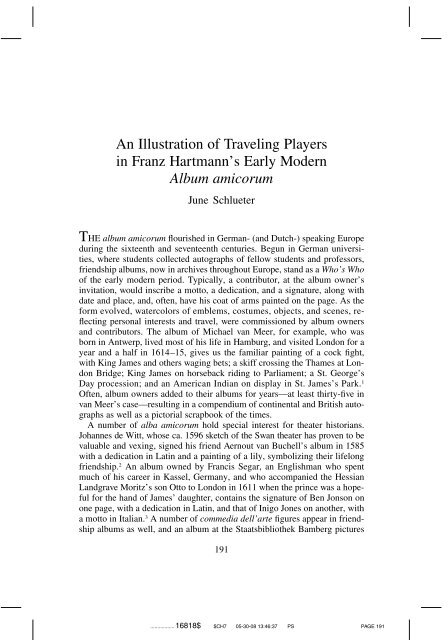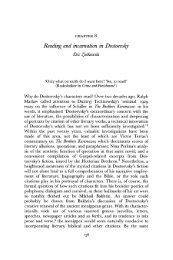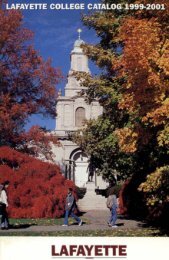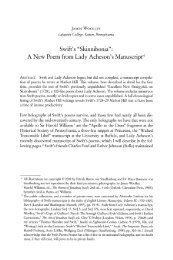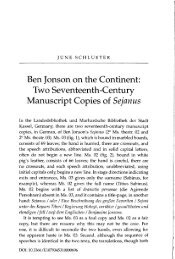Create successful ePaper yourself
Turn your PDF publications into a flip-book with our unique Google optimized e-Paper software.
An Illustration of Traveling Players<br />
in Franz Hartmann’s Early Modern<br />
<strong>Album</strong> <strong>amicorum</strong><br />
June Schlueter<br />
THE album <strong>amicorum</strong> flourished in German- (and Dutch-) speaking Europe<br />
during the sixteenth and seventeenth centuries. Begun in German universities,<br />
where students collected autographs of fellow students and professors,<br />
friendship albums, now in archives throughout Europe, stand as a Who’s Who<br />
of the early modern period. Typically, a contributor, at the album owner’s<br />
invitation, would inscribe a motto, a dedication, and a signature, along with<br />
date and place, and, often, have his coat of arms painted on the page. As the<br />
form evolved, watercolors of emblems, costumes, objects, and scenes, reflecting<br />
personal interests and travel, were commissioned by album owners<br />
and contributors. The album of Michael van Meer, for example, who was<br />
born in Antwerp, lived most of his life in Hamburg, and visited London for a<br />
year and a half in 1614–15, gives us the familiar painting of a cock fight,<br />
with King James and others waging bets; a skiff crossing the Thames at London<br />
Bridge; King James on horseback riding to Parliament; a St. George’s<br />
Day procession; and an American Indian on display in St. James’s Park. 1<br />
Often, album owners added to their albums for years—at least thirty-five in<br />
van Meer’s case—resulting in a compendium of continental and British autographs<br />
as well as a pictorial scrapbook of the times.<br />
A number of alba <strong>amicorum</strong> hold special interest for theater historians.<br />
Johannes de Witt, whose ca. 1596 sketch of the Swan theater has proven to be<br />
valuable and vexing, signed his friend Aernout van Buchell’s album in 1585<br />
with a dedication in Latin and a painting of a lily, symbolizing their lifelong<br />
friendship. 2 An album owned by Francis Segar, an Englishman who spent<br />
much of his career in Kassel, Germany, and who accompanied the Hessian<br />
Landgrave Moritz’s son Otto to London in 1611 when the prince was a hopeful<br />
for the hand of James’ daughter, contains the signature of Ben Jonson on<br />
one page, with a dedication in Latin, and that of Inigo Jones on another, with<br />
a motto in Italian. 3 A number of commedia dell’arte figures appear in friendship<br />
albums as well, and an album at the Staatsbibliothek Bamberg pictures<br />
191<br />
................. 16818$ $CH7 05-30-08 13:46:37 PS<br />
PAGE 191
192 JUNE SCHLUETER<br />
a late sixteenth-/early seventeenth-century outdoor stage with five actors/musicians.<br />
4<br />
Such pages are not abundant: aside from the commedia figures, I have<br />
come across only a handful of theater-related entries in the fifteen hundred<br />
or so albums I have thus far examined. But there is one watercolor that is, to<br />
say the least, intriguing (see figure 1). It appears on f. 25 of the early modern<br />
album of Franz Hartmann of Frankfurt an der Oder, Germany. 5 Painted with<br />
colors that remain bright, the illustration depicts six figures, in costume, on a<br />
cobblestone pavement, against a blue sky. Three—in pink, green, and blue<br />
robes, white ruffs, and helmets with plumes matching the colors of their<br />
robes—carry, respectively, a falcon, a model of a church, and a model of<br />
a boat; one—in red robe, white ruff, and golden crown atop long flowing<br />
hair—carries a flaming heart or ball. The four ride horses, while two—in<br />
doublets, ruffs, and bird masks, carrying torches—walk.<br />
The painting, of course, could be allegorical, as at least two other paintings<br />
in the Hartmann album are. One, on f. 7, is of a young man straddling the<br />
ball of Fortune as he is pulled by contending forces: on one side, a man with<br />
bags of gold and silver; on the other, an attractive young woman. Another,<br />
on f. 137, shows the figure of a prince against a mountainous landscape, with<br />
A watercolor painting, c. 1605–6, from the album of Franz Hartmann. Permission of<br />
British Library.<br />
................. 16818$ $CH7 05-30-08 13:47:19 PS<br />
PAGE 192
AN ILLUSTRATION OF TRAVELING PLAYERS 193<br />
a vertically divided male figure on either side: one is half bishop, half man in<br />
loincloth with oil lamp; the other is half scholar, book in arm, half military<br />
man in armor with pike. Both illustrations represent common tropes in German<br />
albums. The subject painting, though unique among album paintings I<br />
have seen, also contains allegorical features: the objects the figures on horseback<br />
carry represent the four elements, with air designated by the falcon,<br />
earth by the church on a plot of land, water by the boat, and fire by the flaming<br />
heart or ball. Moreover, the two figures on foot, in rooster and owl masks,<br />
round out the conventional display as Night and Day. 6 Indeed, the scene is<br />
much like that in a 1564 print after Maarten van Heemskerck (see figure 2),<br />
in which figures on a processional car are associated with similar representations<br />
of the sister elements, with Night and Day—cutouts of a moon and a<br />
sun atop winged horses’ heads—leading the way. 7<br />
But the album painting and the van Heemskerck print show marked differences<br />
as well. Van Heemskerck’s depiction of the processional car, like those<br />
in the other album paintings, is unmistakably allegorical. Each of the four<br />
figures on the car, as well as a fifth, the coachman, representing Time, may<br />
have been performers in the 1561 Circumcision Procession in Antwerp on<br />
The Triumph of Mundus, after a 1564 print by Maarten van Heemskerck. Permission<br />
of Rijksprentenkabinet, Amsterdam.<br />
................. 16818$ $CH7 05-30-08 13:47:55 PS<br />
PAGE 193
194 JUNE SCHLUETER<br />
which the illustration is based. But the inclusion of the four Winds, to complete<br />
the cosmic portrait, confirms the print’s allegorical nature, as does its<br />
place in the Circulus vicissitudinis rerum humanarum, a series of eight prints<br />
designed to present a moral lesson (pointed in Latin verses). 8 The van Heemskerck<br />
print combines the historical moment of the ceremonial procession<br />
with the moral significance of the Triumph of Mundus, embellishing, stylizing,<br />
and idealizing what a spectator would have seen.<br />
The album painting, by contrast, is unmistakably realistic: the scene we see<br />
is the scene a person standing at the roadside would have seen. The objects<br />
the figures carry do represent the four elements, but the allegory here is neither<br />
coherent nor sustained. Compare the headgear of the four elements on<br />
the car in the van Heemskerck print with the plumed helmets and crown of<br />
those on horseback in the album painting. In the print, each wears a further<br />
token of her allegorical status; in the album, neither the headgear nor the<br />
costumes contribute to or even complement the allegorical message. Indeed,<br />
in the album painting, it would appear that the significance of the objects is<br />
embodied not in the present moment but in an anticipated one. Clearly, there<br />
is a performance element to the painting, but the performance is not yet realized.<br />
Instead, there is a sense of anticipation, with a future event promising<br />
to actualize all the objects: falcon, church, boat, flame, helmets, crown, long<br />
flowing hair, and masks. In short, a person along the roadside and a currentday<br />
reader of the painting would see not an allegorical procession but a<br />
troupe of traveling players, with objects and gear that attract attention along<br />
the way and serve as stage properties at a future time.<br />
Where, though, might Hartmann have seen a troupe of traveling players?<br />
And who might these players be?<br />
Reconstructing the chronology of alba <strong>amicorum</strong> is a knotty task, for except<br />
for the early leaves of the album, which are conventionally reserved for<br />
princes of high estate (King James, Frederick V, the Landgraves of Germany,<br />
for example), signature pages were selected arbitrarily: even when two people<br />
were asked to sign on the same occasion, one might choose f. 120, the other<br />
f. 45v. Moreover, while many contributors inscribe both the date and place<br />
of signing, just as many do not, and watercolor illustrations are often undated<br />
and unidentified. Still, by mapping the chronology of an album, one can establish<br />
context and often infer where and when an illustration was done. In<br />
the case of the Hartmann album, entries span twenty years, from 1597 to<br />
1617. 9 Those that indicate place fall into two time frames: 1605–7, with numerous<br />
entries from Marburg (1605–6) and a few from Giessen, Tübingen,<br />
and Hamburg (1606–7), and 1614–17, with entries from Strasbourg (Argentoratum)<br />
(1614–15), Paris (Lutetia Parisiorum) (1615), Angers (1615–16),<br />
England (1616), and Paris again (1616–17). Dedications to Hartmann indicate<br />
that he was a degree candidate at Marburg, which means he kept his<br />
album while a university student there. In or before 1614, Hartmann traveled<br />
................. 16818$ $CH7 05-30-08 13:47:56 PS<br />
PAGE 194
AN ILLUSTRATION OF TRAVELING PLAYERS 195<br />
to France, then to England, album in hand. (Indeed, although there are only<br />
four entries identifying England as the place of inscription, Hartmann secured<br />
the earliest of these on a date of some import to Shakespeareans: April<br />
23, 1616.)<br />
Aside from coats of arms and a number of paintings on pages signed by<br />
contributors, the Hartmann album contains at least eight watercolors, including<br />
the traveling players, that appear to have been done by the same hand.<br />
One of these is dated Marburg 1605; another is sited Marburg but bears no<br />
date: the album’s chronology, however, implies that it, too, is from 1605–6.<br />
Indeed, stylistic and technical similarities among these paintings—<br />
particularly the positioning of four of them, including the traveling players,<br />
sideways on the page—suggest that most or all were from Hartmann’s university<br />
years.<br />
But what of the figures in the Hartmann album? Other historical paintings<br />
in the album are of courtship and tavern scenes, perhaps particular to Marburg.<br />
What in 1605–6 Marburg might have prompted this more exotic illustration?<br />
The question, though almost certainly unanswerable, is nonetheless<br />
seductive, for what we know about traveling players in Germany suggests<br />
that a German could have seen such a troupe in 1605–6 Marburg. And—even<br />
more provocative—the actors could have been English.<br />
Much of what follows, of course, is conjectural: we cannot know what<br />
prompted the illustration. But we do know a fair amount about traveling players<br />
in Germany. And we know that Marburg and the Academia Marpurgensis,<br />
where Hartmann studied, was in a line of theatrical activity associated with<br />
the Landgrave Moritz, who not only kept English actors at court in Kassel<br />
but regularly lent the actors to others, endorsed their appearance at the Frankfurt<br />
am Main fair, and, in 1604–6, built the English-style Ottoneum theater. 10<br />
As the halfway point between Kassel and Frankfurt am Main—a journey of<br />
ninety-odd miles—and as the site of the university begun by the Landgrave<br />
Moritz’s grandfather, Philipp der Großmütige, in 1527, Marburg was likely<br />
to have seen English actors, in performance or on their way to and from the<br />
fair.<br />
Records of the Frankfurt fair indicate that English actors from the Kassel<br />
court regularly performed there, both at Easter and in the fall, from 1600 to<br />
1613. In an informative 1978 Heidelberg University master’s thesis, Peter<br />
Brand 11 traces the travels of the best-known of the continental actor-managers,<br />
Robert Browne, whose association with the Landgrave Moritz dates back<br />
at least to 1595. In 1605–6, the Landgrave’s troupe of English actors, having<br />
returned from France and spent the winter in Kassel, were given a letter from<br />
their patron commending them to the Frankfurt officials. Twice in 1606, the<br />
troupe of fourteen to seventeen players traveled to the Frankfurt fair. They<br />
performed at the Easter fair in April, after which they returned to Kassel. In<br />
June, they were in Strasbourg, in early August in Ulm. In late August, fifteen<br />
................. 16818$ $CH7 05-30-08 13:47:56 PS<br />
PAGE 195
196 JUNE SCHLUETER<br />
persons, including Robert Browne, John Green, Robert Ledbetter, 12 and other<br />
players from Moritz’s court, were, once again, at the Frankfurt fair, after<br />
which they returned to Kassel. 13 The journey (of six days?) would likely have<br />
taken them to—or at least through—Marburg.<br />
The scenario, though grounded in archival materials, is imaginary, for<br />
there is no known record of the English actors in Marburg in 1605–6. Nonetheless,<br />
it is not unlikely. Two letters from 1597 establish a connection between<br />
the Landgrave Moritz and theatrical activity in Marburg. The first<br />
indicates that Moritz lent Landgrave Ludwig of Marburg costumes and properties<br />
in order that the comedy of the Old Potentates might be performed; it<br />
was a performance that Moritz himself hoped to attend. The second records<br />
Ludwig’s return of the costumes and properties to Moritz following a performance<br />
that was seen by Grave Hans Ernest von Solms. 14 Alternatively,<br />
Hartmann could have seen the actors in Kassel, at the Frankfurt fair, or elsewhere;<br />
sufficiently intrigued, he could have had the players painted in his<br />
album. <strong>Album</strong>s, after all, were not only records of one’s circle of acquaintances<br />
and one’s travels, prompted by motives similar to those of modernday<br />
autograph seekers and vacation photographers; they were also acts of<br />
self-representation, designed to draw attention to the album owner as a man<br />
of experience and learning: perhaps the album owner here wished to show<br />
his knowledge of something his friends may not have seen. Or perhaps he<br />
was still excited over having seen the players perform. For despite Fynes Moryson’s<br />
disdain for the English actors he saw at the Frankfurt fair in 1592,<br />
the English traveler did remark on the undiscriminating German audience,<br />
who ‘‘flocked wonderfully to see theire gesture and Action.’’ 15 And Balthasar<br />
Baumgartner the Younger, of Nuremberg, who also saw the players at the<br />
Frankfurt fair in 1592, reported in a letter to his wife that he was greatly<br />
impressed with the English comedians’ music and their talents at leaping and<br />
dancing. (He also mentioned that they were ‘‘khöstlich herrlich wol<br />
geklayded’’—wonderfully splendidly dressed.) 16 Either way, Hartmann’s<br />
album <strong>amicorum</strong> offered him an opportunity to create a pictorial record of<br />
the traveling troupe.<br />
But what of the painting itself? What can we learn from the figures on the<br />
horses and the two masked figures that lead them? Of immediate interest is<br />
the representation of gender: clearly the crowned player in red, with flowing<br />
hair, is intended to be a princess or queen. But what of the figure who brings<br />
up the rear? Is this a boy actor, dressed in a woman’s skirt? (Note that neither<br />
he/she nor the princess/queen is riding sidesaddle.) And what of the other<br />
two, in green and blue? Are they, too, in skirts, or are they in men’s robes?<br />
(The horses’ heads obscure the line of the fabric.) Three of the players on<br />
horseback wear plumed helmets: what should we make of their headgear?<br />
And what of the properties they carry? The falcon that sits on one player’s<br />
fist may or may not be alive, but it is clearly outfitted for hawking, with hood,<br />
................. 16818$ $CH7 05-30-08 13:47:56 PS<br />
PAGE 196
AN ILLUSTRATION OF TRAVELING PLAYERS 197<br />
jesses, and bell. Might we learn something of the character from the bird?<br />
The August 13 entry in R. Chambers’s Book of Days observes that ‘‘the grade<br />
of the hawk-bearer was known also by the bird he bore’’: a gerfalcon (for a<br />
king), a falcon-gentle (for a prince), a falcon of the rock (for a duke), a peregrine-falcon<br />
(for an earl), a merlin (for a lady), a goshawk (for a yeoman), a<br />
nobby (for a young man), a kestrel (for the ordinary servingman). 17 Two other<br />
players carry a model church and a model boat: do these represent larger<br />
sets the troupe would have carted with them—or did traveling players use<br />
economical, ‘‘Brechtian’’ indicators in production? Moryson, who saw the<br />
same performers as Baumgartner, observes that they had ‘‘nether a Complete<br />
number of Actours, nor any good Appareil, nor any ornament of the Stage.’’ 18<br />
But that was in 1592; once the actors were under the patronage of the Landgrave<br />
Moritz, did the circumstances of their performance change? Or did<br />
such properties, along with the falcon, church, boat, and flame, function allegorically<br />
in performance? And what of the two masked figures at the front?<br />
Are they part of a performance involving the four elements, or are they costumed<br />
for a masque or an entre-act? Is the rooster related to the cock of<br />
classical mime, the Chanticleer of medieval fabliaux, the Cucurucu of the<br />
commedia? And, finally, is the painting generic, or are these particular players<br />
costumed for a particular play?<br />
Some months after the English actors returned to Kassel for the winter of<br />
1606–7, Johann Eckel, an official at the Kassel court, informed the Landgrave<br />
Moritz of the actors’ dissatisfaction with their compensation; if it did not improve,<br />
their last performance at Kassel would be the Comoedia vom Konig<br />
auß England ud Schottland wie die beide gegen einand kreig führten, da der<br />
eine des Andern Sohn d Ander des Andern tochter gefangn hatte [The Play<br />
of the King of England and Scotland, how the two waged war against each<br />
other, where the one takes the Other’s Son and the Other the Other’s daughter<br />
prisoner]. 19 Might the players have performed this six-character play at<br />
the Frankfurt fair, just prior to their return to Kassel? If the Hartmann painting<br />
is of a particular troupe, could the player in red have been the captive<br />
princess, the player with the falcon the captive prince? Or could they have<br />
performed the Tragedy of Julius and Hyppolita, another six-character play in<br />
the repertory of the English actors? The characters in that play, involving the<br />
marriage of one brother and the departure of the other, are a prince, a princess,<br />
two Roman brothers, and two servants. 20<br />
German records identify a number of plays that were performed by English<br />
actors on the continent, some carried there by Robert Browne. Those known<br />
to have been presented by the Kassel actors include (by title or description)<br />
Comedy of Abraham and Lot and of the destruction of Sodom and Gomorrah;<br />
Of a King of England who fell in love with a goldsmith’s wife and abducted<br />
her; Comedy of the prodigal son; Of a pious woman of Antwerp; Of a duke<br />
of Florence who fell in love with a nobleman’s daughter; Of Nobody and<br />
................. 16818$ $CH7 05-30-08 13:47:57 PS<br />
PAGE 197
198 JUNE SCHLUETER<br />
Somebody; Of the two brothers King Ludwig and King Frederick of Hungary.<br />
King Frederick had all stabbed and murdered; Of a King of Khipern, of a<br />
Duke of Venice; 21 Of a rich man and of Lazarus; Comedy of Amadis; 22 and<br />
three that may be versions of Marlowe plays: Fortunatus, Von dem Doctor<br />
Faustus, and Vom dem Jude.<br />
Clearly, the painting of the traveling players poses more questions than it<br />
answers. The album context has yielded a time and a place, but as yet we<br />
know of no archival documents that can, with authority, fill in the narrative.<br />
Yet like the de Witt sketch of the Swan theater—extant through the copy<br />
made by van Buchell—and the Peacham drawing of Titus Andronicus—or a<br />
German version of the play—the Hartmann illustration claims a unique place<br />
in the early modern theatrical record.<br />
Notes<br />
An earlier version of this essay was presented at the theater history seminar at the<br />
Shakespeare Association of America conference in Philadelphia, April 13–15, 2006.<br />
1. Edinburgh University Library, La.III.283. See my ‘‘Michael van Meer’s <strong>Album</strong><br />
Amicorum, with Illustrations of London, 1614–15,’’ The Huntington Library Quarterly<br />
69.2 (2006): 301–13.<br />
2. Kunstbibliothek Berlin, Lipp 0Z3.<br />
3. Huntington Library, HM 743. See my ‘‘His Great-Granduncle’s <strong>Album</strong> <strong>amicorum</strong>:<br />
Francis Segar and the International Network of Early Modern Englishmen,’’<br />
forthcoming.<br />
4. See, among others, the albums of Gervasius Fabricius of Salzburg (1603–37),<br />
British Library, Add 17025, and Frederic de Botnia of Saumur (1616–18), British<br />
Library, Add 16889. The Bamberg illustration, I Qc 75, is reproduced in Werner Taegert,<br />
Edler Schatz holden Erinnerns: Bilder in Stammbüchern der Staatsbibliothek<br />
Bamberg aus vier Jahrhunderten (Bamberg: Staatsbibliothek Bamberg, 1995), 67.<br />
5. British Library, Eg 1222.<br />
6. I am grateful to David Landman for pointing out the allegorical features of the<br />
painting.<br />
7. I am grateful to John Astington for drawing my attention to the van Heemskerck<br />
print.<br />
8. The text for the lead car, The Triumph of the World, identifies the figures and<br />
ends with this comment: ‘‘How swiftly do immutable laws on earth engender the rotary<br />
motion which reveals everything in its turn.’’ Ilja M. Veldman, Maarten van<br />
Heemskerck and Dutch Humanism in the Sixteenth Century (Maarssen: Gary<br />
Schwartz, 1977), 137. Although these ‘‘after Heemskerck’’ prints have been attributed<br />
to Dirck Coornhert, Veldman suggests they were done by Cornelis Cort. See Veldman,<br />
133–41, for a discussion of the print series.<br />
9. One of four 1597 entries is sited Frankfurt an der Oder. These entries are the<br />
oldest in the album, which does not start in earnest until 1605.<br />
................. 16818$ $CH7 05-30-08 13:47:57 PS<br />
PAGE 198
AN ILLUSTRATION OF TRAVELING PLAYERS 199<br />
10. See my ‘‘English Actors in Kassel, Germany, during Shakespeare’s Time,’’<br />
Medieval and Renaissance Drama in England 10 (1998): 238–61.<br />
11. Peter Brand, ‘‘Der englische Komödiant Robert Browne, (1563-ca. 1621/39)’’<br />
(master’s thesis, Heidelberg University 1978).<br />
12. John Green’s name appears frequently in continental records. Those that place<br />
him with Browne include June 1606 Strasbourg and the 1606 fall Frankfurt fair. Robert<br />
Ledbetter is on record with Browne in 1599 and 1601, as well as 1606. The ‘‘Johan<br />
Le Peter’’ in a 1606 letter regarding the Frankfurt Easter fair from ‘‘Robert Browne,<br />
Johan Le Peter, and other Hessische commediens’’ may be an elision of John Green<br />
(Johan Grün) and Robert Ledbetter.<br />
13. An October 1606 record indicates they played in Nuremberg: they may have<br />
stopped there after Frankfurt or made the trip after returning to Kassel.<br />
14. Christoph von Rommel, Geschichte von Hessen 6 (Cassel: Frederich Perthes,<br />
1837), 402n, offers a modernized transcript of Landgrave Moritz’s letter, which he<br />
says is to an unidentified princely person. Hans Hartleb, Deutschlands erster Theaterbau:<br />
Eine Geschichte des Theaterlebens und der englischen Komödianten unter Landgraf<br />
Moritz dem Gelehrten von Hessen-Cassel (Berlin and Leipzig: Walter de Gruyter,<br />
1936), 53, relying on the manuscript in the Hessisches Staatsarchiv Marburg, ‘‘Correspondenz<br />
L. Moritz mit landgr. Ludwig IV. 1597,’’ identifies the addressee as Landgrave<br />
Ludwig IV of Hessen-Marburg and fixes the date as February 1597. Both<br />
Rommel, 401f, and Hartleb, 30–31, refer to Landgrave Ludwig’s return of the borrowed<br />
items after Grave Hans Ernst von Solms and his company saw the performance.<br />
15. Shakespeare’s Europe: A Survey of the Condition of Europe at the end of the<br />
16th century. Being unpublished chapters of Fynes Moryson’s Itinerary (1617). With<br />
an Introduction and an Account of Fynes Moryson’s Career by Charles Hughes, 2d<br />
ed. (1903; New York: Benjamin Blom, 1967), 304.<br />
16. Georg Steinhausen, ed., Briefwechsel Balthasar Baumgartners des Jüngeren<br />
mit seiner Gattin Magdalena, geb. Behaim (1582–1598) (Tübingen: Litterarischer<br />
Verein in Stuttgart, 1895), 176.<br />
17. R. Chambers, ed., The Book of Days: A Miscellany of Popular Antiquities in<br />
Connection with the Calendar including Anecdote, Biography, and History, Curiosities<br />
of Literature, and Oddities of Human Life and Character, vol. 2 (Philadelphia: J.<br />
B. Lippincott, 1899), 211.<br />
18. Shakespeare’s Europe, 304.<br />
19. Hartleb, Deutschlands erster Theaterbau, 53.<br />
20. The texts of Eine Schöne Lustig Triumphirende Comœdia von Eines Königes<br />
Sohne auss Engellandt und des Königes Tochter auss Schottlandt and Tragædia von<br />
Julio und Hyppolita may be found in Spieltexte der Wanderbühne, ed. Manfred<br />
Brauneck, vol. 1 (Berlin: Walter de Gruyter, 1970), 211–68 and 427–59.<br />
21. Of a King of Khipern, a Duke of Venice may be related to Othello, with ‘‘Khipern’’<br />
a German version of Kypros (Greek) or Kibris (Turkish) for Cyprus.<br />
22. The records also provide titles or descriptions of plays that were ‘‘probably’’ or<br />
‘‘perhaps’’ in the Kassel actors’ repertory. Identified as such by Christiane Engelbrecht,<br />
Wilfried Brennecke, Franz Uhlendorff, and Hans Joachim Schaefer, Theater<br />
in Kassel: Aus der Geschichte des Staatstheaters Kassel von den Anfängen bis zur<br />
Gegenwart (Kassel: Bärenreiter, 1959), 7–8, these include Comoedia Otto Schutz<br />
................. 16818$ $CH7 05-30-08 13:47:57 PS<br />
PAGE 199
200 JUNE SCHLUETER<br />
[Comedy Otto Schutz (written by the Landgrave Moritz)]; Die Belohnung der Gottesfurcht<br />
[The Reward of the Godfearing]; Ariodante und Ginevra; Komedia von Tarquinio<br />
und Lukretia; Speculum aistheticum (‘‘probably’’); Vincentius Ladislaus, Satrap<br />
von Mantua (written by Heinrich Julius of Braunschweig); Romeo und Julia; Viel<br />
Lärm um Nichts [Much Ado About Nothing]; Komödie der Irrungen [Comedy of Errors];<br />
Spanish Tragedy; Sidonia und Theagenes; Julius und Hypolita; and Titus Andronicus<br />
(‘‘perhaps’’).<br />
German titles or descriptions of the plays that were surely performed by the Kassel<br />
actors are Comoedia von Abraham und Loth und vom Untergang von Sodom und Gomorra;<br />
Fortunatus; Von einem König aus England, der sich in eines Goldschmidts<br />
Weib verliebte und sie enführte; Comoedie vom verlorenen Sohn; Von einer frommen<br />
Frauen von Antworf; Von dem doctor Faustus; Von ein Herzog von Florenz, der sich<br />
in sines Edelmanns Tochter verliebt hat; Von Niemandts und Jemand; Von dem Jude;<br />
Von den zwei Brüder König Ludwig und König Friedrich von Ungarn. Hats der König<br />
Friedrich als errstocher und ermordet; Von ein Konig Friedrich von ein Herzog von<br />
Venedig; Von dem reichen Mann und von dem Lazarus; and Comoedi aus dem Amadi.<br />
................. 16818$ $CH7 05-30-08 13:47:57 PS<br />
PAGE 200


